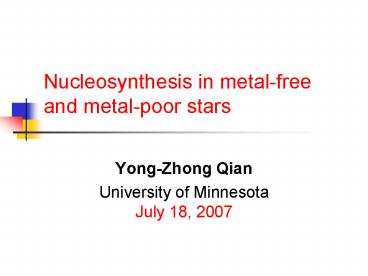Nucleosynthesis in metalfree and metalpoor stars - PowerPoint PPT Presentation
1 / 32
Title:
Nucleosynthesis in metalfree and metalpoor stars
Description:
(C from He burning. mixed into H burning. shell CN cycle), also sources for C, O ... Hydrostatic and explosive burning. From C to the Fe group ... – PowerPoint PPT presentation
Number of Views:52
Avg rating:3.0/5.0
Title: Nucleosynthesis in metalfree and metalpoor stars
1
Nucleosynthesis in metal-free and metal-poor
stars
- Yong-Zhong Qian
- University of MinnesotaJuly 18, 2007
2
Effects of metallicity
- Star formation (Talks by Norman, Glover, Tan,
Bromm, Omukai, Shull) - Stellar evolution (Talks by Woosley, Yoon,
Meynet, Ekstrom, Pols, Suda) - Explosion and nucleosynthesis (Talks by Woosley,
Nomoto, Herwig, Asplund, Cristallo, Campbell) - A label to indicate time
3
The case of pair-instability SN
- Possible only at 0 metallicity
- , little mass loss
without rotation (Baraffe et al. 2001) - Good understanding of explosion and
nucleosynthesis (Heger Woosley 2002 Umeda
Nomoto 2002) - Distinct signature of nucleosynthesis
4
Heger Woosley 2002
deficiency of odd Z elements
5
Tumlinson et al. 2004
6
Pair-instability SNe?
- Progenitors cannot be formed?
- Formed but nucleosynthetic signatures overwhelmed
by other sources? - Formed but mass reduced during evolution? (Talk
by Ekstrom) - What about the possible detection of a modern
PI-SN? (Talk by Smith)
7
Other sources at 0 metallicity
- intermediate-mass
black holes, jet-powered explosion
abundances in ICM
Ohkubo et al. 2006
8
(continued)
abundances in extremely metal-poor stars
Ohkubo et al. 2006
9
Rotating massive stars at low metallicity N
sources (Talk by Chiappini Figure from Chiappini
et al. 2006)
10
Low and intermediate-mass stars at low metallicity
with rotation enhanced primary N production (C
from He burning mixed into H burning shell CN
cycle), also sources for C, O (Meynet Maeder
2002)
N yield
weighted by IMF
11
Abundances in carbon-rich extremely metal-poor
stars
Meynet et al. 2006
12
s-process at low metallicity
(Gallino et al. 1998)
Aoki et al. 2006
Van Eck et al. 2001
13
Cosmic rays at low metallicity The puzzle of
(Talk by Asplund)
Cosmic rays or BBN with exotic particles?
corrected for
depletion
Asplund et al. 2006
14
Major nucleosynthetic sources at low metallicity
massive stars
- Hydrostatic and explosive burning
- From C to the Fe group
- broadly similar yields with some important
dependence on metallicity through mass loss,
pre-SN structure, and details of explosion - (Woosley Weaver 1995 Chieffi Limongi
2002 Tominaga et al. 2007)
15
Tominaga et al. 2007
Mass cut, fallback, mixing
Normal SN
HN Zn/Fe to fix Mcut(ini)
A Si burning region O/Fe
B O burning region Mg/Fe
for
only
16
Deficiencies K, Sc, Ti, Mn, Co Remedies
changing or ?
Tominaga et al. 2007
Faint SN
Hypernova
17
Supernova as a neutrino phenomenon
18
Evolution of in the neutrino-heated ejecta
(Qian et al. 1993 Fuller Meyer 1995 Qian
Woosley 1996 McLaughlin et al. 1996)
19
Qian Woosley 1996
Sensitivity of nucleosynthesis to
(Hoffman et al. 1996)
20
(Pruet et al. 2005 Frohlich et al. 2006)
with neutrinos
without neutrinos
21
(No Transcript)
22
Nucleosynthesis in proton-rich winds
(Frohlich et al. 2006 Pruet et al. 2006 Wanajo
2006)
23
Dependence on number of neutrons captured per
seed (Pruet et al. 2006)
24
(No Transcript)
25
Hoffman, Woosley, Qian 1997
26
(No Transcript)
27
(No Transcript)
28
(Hoffman et al. 1997 Meyer Brown 1997
Freiburghaus et al. 1999)
29
Typical Conditions in the Wind
(Witti et al. 1994 Qian Woosley 1996
Thompson et al. 2001)
Production of A 130 likely Production of A
195 uncertain
Proposed sources for A 195 modified winds
(e.g., Thompson 2003 Wanajo 2006) disk winds
(Pruet et al.03McLaughlin Surman05) ejecta
from SN fallback (Fryer et al. 2006)
30
Summary
- Origin of at low metallicity still a
puzzle (BBN or cosmic rays or ?) - N at low metallicity indicating rotation
- Pb in metal-poor binary members indicating
s-process at low-metallicity - C to Fe group in metal-poor stars suggesting
normal SN
31
Summary (continued)
- abundance patterns in extremely metal-poor stars
indicating contributions from hypernova and faint
SN - SN neutrinos interconvert protons and neutrons,
thereby enabling a number of nuclei beyond the Fe
group to be made under proton-rich conditions
32
Summary (continued)
- Neutron-rich neutrino-driven winds from new-born
neutron stars can easily produce Sr, Y, Zr, , Ag
(A 88 - 110) - Production of r-process elements with A up to 130
in such winds is likely - Where the production of r-process elements with A
gt 130 occurs remains a mystery

